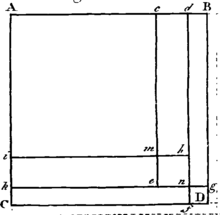William Cockin
William Cockin (baptised 1736 – 1801) was an English schoolmaster and versatile author.[1]
William Cockin | |
|---|---|
| Born | 1736 |
| Died | 30 May 1801 (aged 65) |
| Occupation | Schoolteacher, writer, accountant |
Life
The son of Marmaduke Cockin (1712–1754), he was born at Burton-in-Kendal, Westmorland. His father was a schoolmaster.[1][2]
After time spent as a teacher in schools in London, Cockin was in 1764 appointed writing-master and accountant to Lancaster Grammar School, a post he held for twenty years. He was then for eight years at John Blanchard's Nottingham Academy.[2]
Cockin retired to Kendal. He was a friend of George Romney the painter, and he died at Romney's house in Kendal, on 30 May 1801, aged 65. He was buried at Burton-in-Kendal.[2]
Associations
Among Cockin's friends was the Rev. Thomas Wilson of Clitheroe, and Peter Romney, brother of George, was a correspondent in the later 1760s.[2][3] Other associates were John Dawson, and Rev. John James D.D., of Arthuret.[1]
Works

Cockin's works included:[2]
- A Rational and Practical Treatise of Arithmetic, 1766.
- Occasional Attempts in Verse, privately printed at Kendal.
- Ode to the Genius of the Lakes, 1780.
- The Theory of the Syphon, 1781.
- The Fall of Scepticism and Infidelity predicted, 1788, in the form of a letter to James Beattie.[1]
- The Freedom of Human Action explained, 1791
- The Rural Sabbath, a poem, 1805. This posthumous volume includes a reprint of the Ode to the Lakes, with biographical notes.
Cockin contributed to the Philosophical Transactions a paper An Account of an Extraordinary Appearance in a Mist near Lancaster.[4]
Elocutionist
In 1775 Cockin published The Art of Delivering Written Language; or, An Essay on Reading, dedicated to David Garrick, a work on elocution.[1] In this book Cockin is representative of the 18th-century elocutionary movement, and within elocutionist he is assigned to the "natural school".[5][6] His comment on the prescriptive approach of Thomas Sheridan, a leader of the movement, was that works of elocution might be as much about perceptions of ways of talking as speaking.[7]
Cockin noted in particular the connection between modulation in speech and silent reading.[8] He pointed out that in both speech and singing, pauses are used to frame and for emphasis.[9] He took comical mimicry to be a low form, in terms of artistic prestige. His exposition on the topic is now a standard authority for this attitude to imitation and mimesis.[10]
Guide books
Thomas West's Guide to the Lakes, on the English Lake District, first appeared in 1778, and Cockin assisted in its compilation.[2] He edited, anonymously, the second edition in 1780, West having died in 1779, including a preface that discussed the sources used: John Brown's Letter on Keswick, Thomas Gray, Thomas Pennant and Arthur Young.[11] This expanded work and a later edition influenced William Wordsworth's 1810 guide.[1] They contained the Letter on Keswick and Gray's Journal of the Lakes as appendices.[12] Other additions included an engraving of Grasmere, after John Feary;[13] Cockin was also responsible for footnotes, and tables of heights of the mountains.[14]
Notes
- Cross, David A. "Cockin, William". Oxford Dictionary of National Biography (online ed.). Oxford University Press. doi:10.1093/ref:odnb/5786. (Subscription or UK public library membership required.)
- Stephen, Leslie, ed. (1887). . Dictionary of National Biography. 11. London: Smith, Elder & Co.
- Heather Birchall, Henry Pickering fl 1740-70: An 18th-century portrait painter, The British Art Journal Vol. 4, No. 1 (Spring 2003), pp. 88–91, at p. 91. Published by: British Art Journal JSTOR 41614438
- Phil. Trans. (1780), lxx. 157.
- Jacqueline George, Public Reading and Lyric Pleasure: Eighteenth Century Elocutionary Debates and Poetic Practices, ELH Vol. 76, No. 2 (Summer, 2009), pp. 371–397 at p. 383. Published by: The Johns Hopkins University Press. JSTOR 27742940
- Kuypers, Jim A.; King, Andrew (2001). Twentieth-century Roots of Rhetorical Studies. Greenwood Publishing Group. pp. 120 nite 53. ISBN 9780275964207. Retrieved 15 May 2018.
- L. C. Mugglestone, Cobbett's Grammar: William, James Paul, and the Politics of Prescriptivism, The Review of English Studies Vol. 48, No. 192 (Nov., 1997), pp. 471–488, at p. 478. Published by: Oxford University Press. JSTOR 518493
- Dana Harrington, Remembering the Body: Eighteenth-Century Elocution and the Oral Tradition, Rhetorica: A Journal of the History of Rhetoric Vol. 28, No. 1, The 2nd Biennial Conference of the Chinese Rhetoric Society of the World – Call for Papers (Winter 2010), pp. 67–95, p. 93 note 81. Published by: University of California Press on behalf of the International Society for the History of Rhetoric DOI: 10.1525/rh.2010.28.1.67 JSTOR 10.1525/rh.2010.28.1.67
- Robert Toft, Rendering the Sense More Conspicuous: Grammatical and Rhetorical Principles of Vocal Phrasing in Art and Popular/Jazz Music, Music & Letters Vol. 85, No. 3 (Aug., 2004), pp. 368–387, at p. 377. Published by: Oxford University Press. JSTOR 3526232
- Jan Rüger, Laughter and War in Berlin, History Workshop JournalNo. 67 (Spring 2009), pp. 23–43, at p. 40, note 44. Published by: Oxford University Press. JSTOR 40646207
- Betty A. Schellenberg, Coterie Culture, the Print Trade, and the Emergence of the Lakes Tour, 1724–1787, Eighteenth-Century Studies Vol. 44, No. 2 (Winter 2011), pp. 203–221, at pp. 214–5. Published by: The Johns Hopkins University Press. Sponsor: American Society for Eighteenth-Century Studies (ASECS). JSTOR 41057329
- Mary R. Wedd, Light on Landscape in Wordsworth's "Spots of Time", The Wordsworth Circle, Vol. 14, No. 4 (Autumn 1983), pp. 224–232, at p. 228. Published by: Marilyn Gaull JSTOR 24040642
- Woof, Robert; Museum, Grasmere and Wordsworth (1982). The discovery of the Lake District, 1750-1810: a context for Wordsworth: at the Grasmere and Wordsworth Museum, 20 May-31 October, 1982. Trustees of Dove Cottage. p. 23.
- Donnachie, Ian; Lavin, Carmen (8 April 2004). From Enlightenment to Romanticism: Anthology II. Manchester University Press. p. 3. ISBN 9780719066733. Retrieved 15 May 2018.
External links
- Attribution
![]()